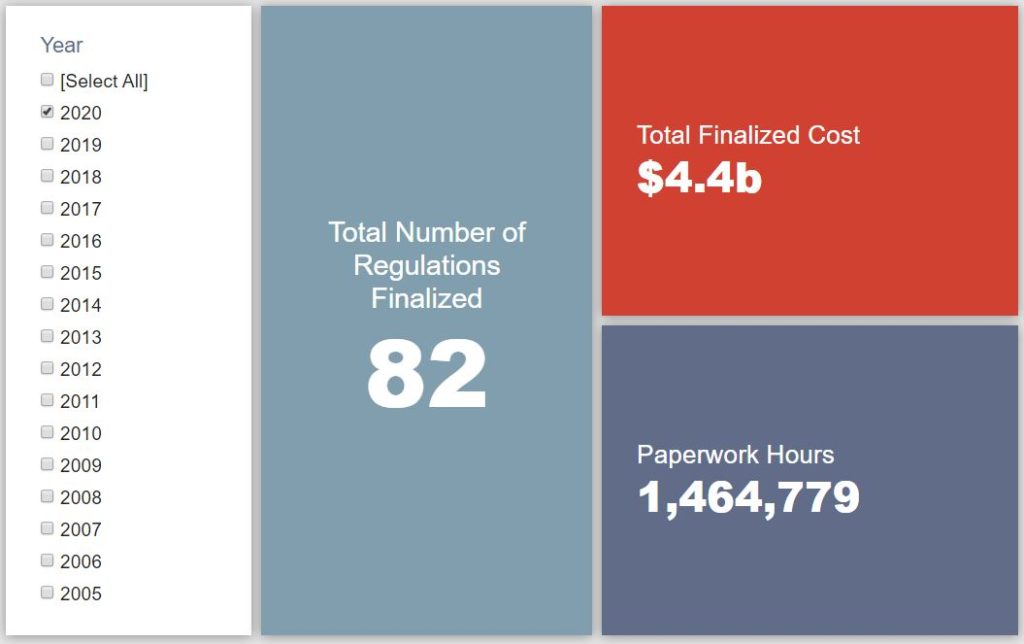Week in Regulation
March 30, 2020
Modest Rulemaking Week as Focus Remains on Pandemic
In the pages of the Federal Register last week, there was a grand total of five rulemakings with some quantified cost or paperwork estimate. While it is difficult to say definitively, this relative lack of activity could be the first sign of the effects of a recent administrative directive to refocus agency resources towards addressing the COVID-19 crisis. Across all rulemakings, agencies published $71 million in total net cost savings and cut 125,008 hours of annual paperwork.
REGULATORY TOPLINES
- 2020 Proposed Rules: 35
- 2020 Final Rules: 55
- 2020 Total Pages: 17,447
- 2020 Final Rule Costs: $4.4 billion
- 2020 Proposed Rule Costs: $3.7 billion
The most notable deregulatory action of the week came from the Securities and Exchange Commission (SEC). This rule adjusts the thresholds that define an “accelerated filer” of required financial disclosure reports. SEC estimates that this will reduce the paperwork burden on certain smaller filers by 140,402 hours each year; bringing annual savings of $50 million. Since SEC is an independent agency, however, these burden reductions do not apply to the fiscal year (FY) 2020 regulatory budget under Executive Order (EO) 13,771
TRACKING THE REGULATORY BUDGET
The most eventful regulatory action (as applied to EO 13,771) is a final rule of the Department of Homeland Security (DHS) regarding “Security Training for Surface Transportation Employees.” The rule requires various ground-level transportation carriers – both freight and passenger – to establish a more robust anti-terrorism training program for their employees. DHS estimates that this requirement will impose $5.3 million in annual costs, or roughly $75 million in net present value.
The Trump Administration expects to reach $51.6 billion in cumulative net savings in FY 2020. To date in the fiscal year, agencies have finalized 68 deregulatory actions and 22 regulatory actions, totaling $3.6 billion in quantified total net costs.
THIS WEEK’S REGULATORY PICTURE
This week, President Trump issues an executive order to address hoarding of critical supplies needed to deal with the coronavirus.
Source: https://www.federalregister.gov/documents/2020/03/26/2020-06478/preventing-hoarding-of-health-and-medical-resources-to-respond-to-the-spread-of-covid-19
On March 23, President Trump signed Executive Order (EO) 13,910, which aims to prevent hoarding of personal protective equipment (PPE) and sanitizing and disinfecting products during the COVID-19 pandemic.
The EO delegates presidential authority under the Defense Production Act (DPA) to the secretary of Health and Human Services (HHS) to designate any material as a scarce material. Under the DPA, anyone found to be hoarding supplies of the named items is subject to a fine of up to $10,000 and up to one year in prison.
On March 25, HHS Secretary Alex Azar designated the list of supplies that cannot be hoarded. The list contains 15 materials, including N-95 masks, ventilators, and PPE.
Despite news reports of people hoarding hand sanitizer and toilet paper, neither item explicitly makes the list (though hand sanitizer could be covered depending on how you read item 8). Instead, the Department of Justice has vowed to crack down on people that hoard these products then attempt to price gouge consumers desperate for them.
TOTAL BURDENS
Since January 1, the federal government has published $8.1 billion in total net costs (with $4.4 billion in finalized costs) and 15.9 million hours of net annual paperwork burden increases (with 1.5 million hours due to final rules). Click here for the latest Reg Rodeo findings.













